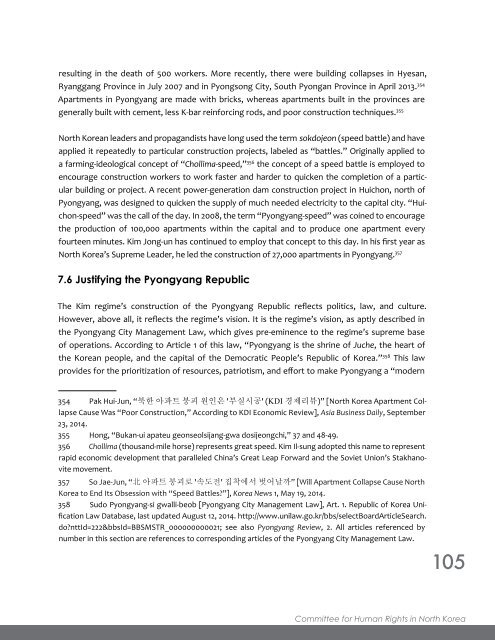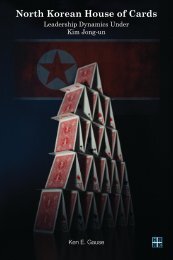REPUBLIC
Collins_PyongyangRepublic_FINAL_WEB
Collins_PyongyangRepublic_FINAL_WEB
You also want an ePaper? Increase the reach of your titles
YUMPU automatically turns print PDFs into web optimized ePapers that Google loves.
esulting in the death of 500 workers. More recently, there were building collapses in Hyesan,<br />
Ryanggang Province in July 2007 and in Pyongsong City, South Pyongan Province in April 2013. 354<br />
Apartments in Pyongyang are made with bricks, whereas apartments built in the provinces are<br />
generally built with cement, less K-bar reinforcing rods, and poor construction techniques. 355<br />
North Korean leaders and propagandists have long used the term sokdojeon (speed battle) and have<br />
applied it repeatedly to particular construction projects, labeled as “battles.” Originally applied to<br />
a farming-ideological concept of “Chollima-speed,” 356 the concept of a speed battle is employed to<br />
encourage construction workers to work faster and harder to quicken the completion of a particular<br />
building or project. A recent power-generation dam construction project in Huichon, north of<br />
Pyongyang, was designed to quicken the supply of much needed electricity to the capital city. “Huichon-speed”<br />
was the call of the day. In 2008, the term “Pyongyang-speed” was coined to encourage<br />
the production of 100,000 apartments within the capital and to produce one apartment every<br />
fourteen minutes. Kim Jong-un has continued to employ that concept to this day. In his first year as<br />
North Korea’s Supreme Leader, he led the construction of 27,000 apartments in Pyongyang. 357<br />
7.6 Justifying the Pyongyang Republic<br />
The Kim regime’s construction of the Pyongyang Republic reflects politics, law, and culture.<br />
However, above all, it reflects the regime’s vision. It is the regime’s vision, as aptly described in<br />
the Pyongyang City Management Law, which gives pre-eminence to the regime’s supreme base<br />
of operations. According to Article 1 of this law, “Pyongyang is the shrine of Juche, the heart of<br />
the Korean people, and the capital of the Democratic People’s Republic of Korea.” 358 This law<br />
provides for the prioritization of resources, patriotism, and effort to make Pyongyang a “modern<br />
354 Pak Hui-Jun, “북한 아파트 붕괴 원인은 '부실시공' (KDI 경제리뷰)” [North Korea Apartment Collapse<br />
Cause Was “Poor Construction,” According to KDI Economic Review], Asia Business Daily, September<br />
23, 2014.<br />
355 Hong, “Bukan-ui apateu geonseolsijang-gwa dosijeongchi,” 37 and 48-49.<br />
356 Chollima (thousand-mile horse) represents great speed. Kim Il-sung adopted this name to represent<br />
rapid economic development that paralleled China’s Great Leap Forward and the Soviet Union’s Stakhanovite<br />
movement.<br />
357 So Jae-Jun, “ 北 아파트 붕괴로 '속도전' 집착에서 벗어날까” [Will Apartment Collapse Cause North<br />
Korea to End Its Obsession with “Speed Battles?”], Korea News 1, May 19, 2014.<br />
358 Sudo Pyongyang-si gwalli-beob [Pyongyang City Management Law], Art. 1. Republic of Korea Unification<br />
Law Database, last updated August 12, 2014. http://www.unilaw.go.kr/bbs/selectBoardArticleSearch.<br />
do?nttId=222&bbsId=BBSMSTR_000000000021; see also Pyongyang Review, 2. All articles referenced by<br />
number in this section are references to corresponding articles of the Pyongyang City Management Law.<br />
105<br />
Committee for Human Rights in North Korea



